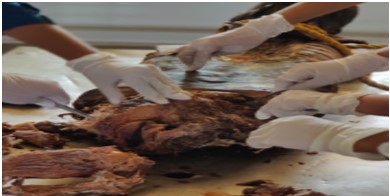A review of Bone Preparation Techniques for Anatomical Studies
DOI:
https://doi.org/10.21760/jaims.8.10.16Keywords:
Osteology, maceration, soft tissue removal, bleaching, degreasingAbstract
The scope of modern anatomy has become very wide because it is now studied by all possible techniques which can enlarge the boundaries of the anatomical knowledge. So, bones are essential part of anatomy teaching curriculum and are unsurpassed in the ability to provide three dimensional instruction in Osteology as well as understanding the sites of soft tissue insertion and the course of neurovascular structures in a region. Many techniques have been employed over the years for preparation of bones. These methods include the use of insects, chemicals and enzymes. Bone preparation involves soft tissue removal, maceration, bleaching and labelling of the bones. The present study conducted with the aim of evaluating the least time-consuming and effective method of bone preparation from embalmed and wet specimens.
Downloads
References
Modi BS, Puri N, Patnaik VVG. Evaluation of techniques for cleaning embalmed cadavers' bones. Int J Anat Res. 2014;2:810-813.
Boyle C. Maceration and preparation of mammal skeleton for long-term curation. Univ Indianapolis Archaeol Forensic Lab. 2010.
Eriksen AM, Simonsen KP, Rasmussen AR. Conservation of mitochondrial DNA in fast enzyme-macerated skeletal material. Int J Conserv Sci. 2013;4:127-132.
Offele D, Harbeck M, Dobberstein RC, von Wurmb-Schwark N, Ritz-Timme S. Soft tissue removal by maceration and feeding of Dermestes sp.: impact on morphological and biomolecular analyses of dental tissues in forensic medicine. Int J Legal Med. 2007;121:341-348.
Ator GA, Andrews JC, Maxwell DS. Preparation of the human skull for skull base anatomic study. Skull Base Surg. 1993;3:1-6.
Christensen AM, Myers SW. Macroscopic observations of the effects of varying fresh water pH on bone. J Forensic Sci. 2011;56:475-479.
Onwuama KT, Salami SO, Ali M, Nzalak JO. Effect of different methods of bone preparation on the skeleton of the African giant pouched rat (Cricetomys gambianus). Int J Morphol. 2012;30:425-427.
Mairs S, Swift B, Rutty GN. Detergent: an alternative approach to traditional bone cleaning methods for forensic practice. Am J Forensic Med Pathol. 2004;25:276-284.
Bartels T, Meyer W. A quick and effective method for the maceration of vertebrates. DTW. Deutsche tierärztliche Wochenschrift. 1991;98:407-409.
Simonsen KP, Rasmussen AR, Mathisen P, Petersen H, Borup F. A fast preparation of skeletal materials using enzyme maceration. J Forensic Sci. 2011;56:480-484.
Ajayi A, Edjomariegwe O, Iselaiye OT. A review of bone preparation techniques for anatomical studies. Malaya J Biosci. 2016;3:76-80.















